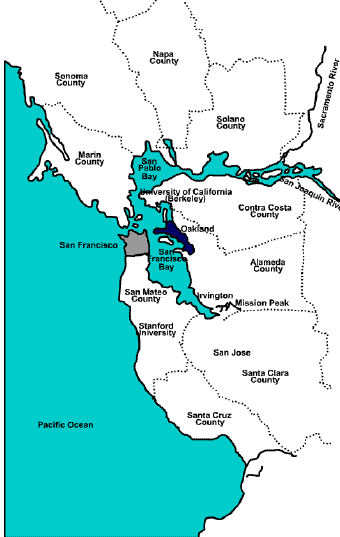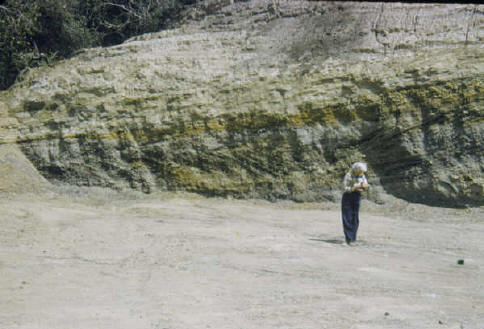|
Chapter 3. Fossil-Bearing Sediments
Where are fossils most often discovered? Wherever man or
the natural processed of erosion expose fossil-bearing sediments to the light of
day. The oil driller often brings up both microscopic and macroscopic fossils
from thousands of feet beneath the earth’s surface. Many fossils have been
found on the surface of dry steam channels; during heavy rains, eroding waters
wash away the sediments covering these specimens. Fossil hunters find specimens
by digging in especially rich areas. Many fossils, however, are exposed by men
digging in sand, gravel, and clay with large excavating machinery. Both man and
natural events, then, share in making discoveries possible.
In the southern portion of Alameda County, the plain extending
eastward from San Francisco Bay ends at a line of low hills. The distance from
the Bay to the hills is about 6 miles. From the top of the hills on a clear day,
the tall buildings of San Francisco can be seen across the Bay to the northwest.
The western (Bay) side of the hills is a steep slope called fault scarp.
A “fault” is a deep fracture in rock, along which vertical or horizontal
movement has taken place; a “scarp” is an incline or cliff formed by the
movement of the rock. Due to the splitting effects along the fault, which at
this locality had been labeled the Hayward Fault, the hills are on one block of
rock and the plain is on another. Because of the downward movement of the Bay
block and the upward movement of the hills block, sedimentary beds along the
hills’ western boundary dip 20 degrees to 25 degrees toward the northeast.
|

The San Francisco Bay region. The
former town of Irvington, now called the Irvington District, is
located, as is Mission Peak, in the city of Fremont |

A Profile view from San Francisco Bay to Mission Peak - Irvington
District, Alameda County, California.
Mission Peak is 2517 feet above sea level.
The beds (strata) are composed of such sediments as clay, sand, and
gravel and are nearly as unconsolidated (loose, uncemented) as when first
deposited by steams in mid-Pleistocene time. These sediments contain rich
concentrations of animal and plant fossils. The richest deposit is about 1 mile
southeast of the center of the former town of Irvington. The area is now called
the Irvington District. It is in the city of Fremont.
 |
| Anna Bell plays with new camera in front of
sediments near Back Hill in 1957. |
Some 3 miles east of the low hills and lying in the Mission District is a
much taller ridge, Mission Peak, 2517 feet above sea level. Millions of years
before the Pleistocene, sediments that now compose the Mission Peak ridge were
deposited by both marine and fresh waters. These sediments are now a rich source
of marine fossils, many of them clams and snails. Also, remains of Desmostylus,
a mammal with characteristics between those of a sea cow and a walrus, have been
found among the remains of seashells. These fossils were buried under marine
water during the late Miocene time, or about 12,000,000 years ago. The Miocene
is one of seven epochs of the Cenozoic era.
|
Geologic Time Scale - Cenozoic Era |
|
Era |
Period |
Epoch |
Beginning
(years ago) |
Duration
(in years) |
| Cenozoic |
Quaternary |
*Recent
Pleistocene |
----------------------
3,500,000 |
----------------------
3,500,000- |
|
Tertiary |
Pliocene
Miocene
Oligocene
Eocene
Paleocene |
14,000,000
26,000,000
40,000,000
55,000,000
65,000,000 |
10,500,000
12,000,000
14,000,000
15,000,000
10,000,000 |
|